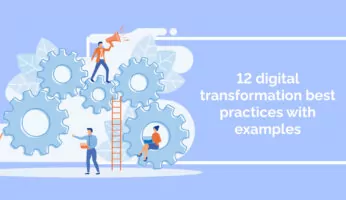
Effective HCM adoption can streamline HR processes across the organization, enhancing critical employee metrics across the board, improving business outcomes, and generating positive ROI for the organization.
However, adopting any enterprise-grade SaaS platform, such as HCM platforms, comes with challenges.
Below, we’ll look at a few ways to overcome these challenges and accelerate the adoption of an HCM platform.
How to Overcome the Top Challenges of HCM Adoption
Let’s look at a few of the obstacles to successfully implementing HCM platforms and how to overcome them.
1. Executive buy-in
Executive support is critical for the success of any business initiative.
A large-scale effort such as HCM platform adoption is no exception.
Successfully implementing a tool will have sweeping impacts on:
- Budgets
- Existing systems
- HR and IT
Demonstrating the ROI of this platform may not be an easy task, but it is essential to earning business leaders’ cooperation.
To that end, it is important to create a business case for the value of HCM platforms.
Here are a few tips for building that case:
- Target the right executives, such as CHROs, CIOs, COOs, and CEOs
- Make a case that speaks to the needs of each executive
- Create a thought-out plan that demonstrates how the HCM platform will be implemented
- Project possible ROI scenarios
- Commit to supporting, if not leading, the implementation effort
In short, don’t just claim that the HCM platform will generate a positive ROI, commit to enacting the change yourself.
2. Resistance to change
Overcoming resistance to change is one of the core goals of change management. Employee resistance, after all, is one of the standard obstacles faced by change managers.
There are several reasons employees resist change.
A few of those include:
- Reticence to learn new things
- Fear of job displacement, inadequacy, or discipline
- Lack of effective communication from managers and leaders
Effective communication is one of the best ways to overcome resistance. When employees don’t know what change is happening or why, they will be more likely to resist change. They will feel alienated and besieged by a change, which will detrimentally affect motivation and engagement.
On the other hand, if they feel that their input matters, they will be more likely to “own” the change and, as a result, they will be more engaged and supportive. For this reason, it is important to invite participation from employees early on during the deployment process.
3. Technology deployment
Technology deployment can be a challenge for several reasons:
- The logistics of deployment can be complex, costly, and time-consuming
- Employees remain motivated to adopt new software, as noted above
- Also, without the right skills, employees will not fully utilize that software
There’s no easy way to overcome these challenges, but there are a several steps you can take to circumvent them.
Here are a few:
- Form a partnership between IT and HR, since these two departments will be pivotal in rolling out the HCM platform
- Implement an employee training program, as mentioned earlier, in order to minimize resistance, upskill employees, and accelerate the adoption of the platform
- Take a structured approach to change management in order to ensure that the deployment stays coordinated and effective
Deployment is not simply about logistics, although that is an important aspect. Instead, as we have seen, deployment also depends heavily on the “human” element – such as communication, motivation, attitudes, and behavior.
4. Generating ROI
Deploying an HCM platform is one thing.
Generating ROI from that platform is another.
To ensure the successful and profitable deployment of an HCM platform, it is necessary to do several things:
- Take a systematic approach to digital adoption
- Manage change in a structured way
- Use a data-driven approach to adoption
- Focus on both skills training as well as the emotional aspects of change
- Measure and optimize key metrics, such as software utilization, employees’ time-to-competency, and software proficiency levels
The points listed here should actually be part of any full-scale digital adoption strategy, which focuses on all of the pillars we have discussed in this article so far – the human side of change, training, a data-driven deployment process, and change management.
ROI should be one among several goals in that strategy, but it shouldn’t be the only one.
5. Goal-driven digital adoption
A complete digital adoption process begins with the initial use of a software application and continues through stages such as:
- Onboarding
- Training
- Ongoing performance improvement
As mentioned above, generating ROI is one of the top aims of adoption, but it is not the only goal.
To maximize the chances of any digital adoption process, including HCM adoption, it is useful to focus on metrics such as:
- Time-to-competency
- Employee sentiment
- Overall proficiency
- Software utilization
- Software ROI
Some of these metrics will require an in depth analysis of business processes, through techniques such as process mining and task mining. These activities can offer insight into exactly how processes have changed since the adoption of the HCM platform – this, in turn, can help business leaders gauge the total impact of the HCM adoption plan.
WalkMe Team
WalkMe spearheaded the Digital Adoption Platform (DAP) for associations to use the maximum capacity of their advanced resources. Utilizing man-made consciousness, AI, and context-oriented direction, WalkMe adds a powerful UI layer to raise the computerized proficiency, everything being equal.



